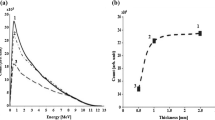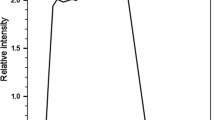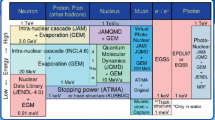Abstract
The continuing need for providing improved facilities for radiation therapies has made investigation of various neutron sources an interesting subject of study. The so-called photoneutron sources are one of the noteworthy candidates for this purpose. In the present study, the possibility of using the 8 MeV–10 mA linac, designed and constructed in Iran, was investigated for BNCT using MCNPX Monte Carlo simulations. By designing optimized target, an adequate neutron yield was achieved and the generated beam was shaped for BNCT. The results show that the proposed beam provides an acceptable agreement between the appropriate neutron intensity and penetrating in tissue.



source particle) corresponding to the 2 mm Ta electron target












Similar content being viewed by others
References
IAEA-TECDOC-1223 (2001) Current status of Neutron Capture Therapy, International Atomic Energy Agency
Herrera MS, González SJ, Minsky DM, Kreiner AJ (2013) Evaluation of performance of an accelerator-based BNCT facility for the treatment of different tumor targets. Phys Medica 29(5):436–446
Magni C, Postuma I, Ferrarini M, Protti N, Fatemi S, Gong C, Bortolussi S (2020) Design of a BNCT irradiation room based on proton accelerator and beryllium target. Appl Radiat Isotopes. 165:109314
Hiraga F (2020) Monte Carlo simulation-based design of an electron-linear accelerator-based neutron source for boron neutron capture therapy. Appl Radiat Isotopes. 162:109203
Monti V, Costa M, Durisi E, Mafucci E, Menzio L, Sans-Planell O, Gomez-Ros JM (2020) The e_LiBANS facility: A new compact thermal neutron source based on a medical electron LINAC. Nucl Instrum Meth A. 953:163154
Tatari M, Ranjbar AH (2014) Design of a photoneutron source based on 10 MeV electrons of radiotherapy linac. Ann Nucl Energy 63:69–74
Pazirandeh A, Torkamani A, Taheri A (2011) Design and simulation of a neutron source based on an electron linear accelerator for BNCT of skin melanoma. Appl Radiat Isotopes 69(5):749–755
Rahmani F, Shahriari M (2011) Beam shaping assembly optimization of Linac based BNCT and in-phantom depth dose distribution analysis of brain tumors for verification of a beam model. Ann Nucl Energy 38(2–3):404–409
Torabi F, Masoudi SF, Rahmani F, Rasouli FS (2014) BSA optimization and dosimetric assessment for an electron linac based BNCT of deep-seated brain tumors. J Radioanal Nucl Chem 300(3):1167–1174
Masoudi SF, Rasouli FS (2015) Investigating a multi-purpose target for electron linac based photoneutron sources for BNCT of deep-seated tumors. Nucl Instrum Meth B 356:146–153
Durisi E, Alikaniotis K, Borla O, Bragato F, Costa M, Giannini G, Zanini A (2015) Design and simulation of an optimized e-linac based neutron source for BNCT research. Appl Radiat Isot 106:63–67
Ghasemi F, Davani FA, Rachti ML, Shaker H, Ahmadiannamin S (2015) Design, construction and tuning of S-band coupler for electron linear accelerator of institute for research in fundamental sciences (IPM E-linac). Nucl Instrum Meth A 772:52–62
Hajari SS, Haghtalab S, Shaker H, Kelisani MD (2018) RF emittance in a low energy electron linear accelerator. Nucl Instrum Meth A 888:250–256
Pelowitz, Denise B (2005) MCNPXTM user’s manual. Los Alamos National Laboratory, Los Alamos
Rasouli FS, Masoudi SF (2015) A study on the optimum fast neutron flux for boron neutron capture therapy of deep-seated tumors. Appl Radiat Isotopes 96:45–51
Haghtalab S, Ghasemi F, Lamehi M, Ahmadian S, Davani FA (2017) Current status of IPM linac control system. In 8th Int. Particle Accelerator Conf.(IPAC'17), Copenhagen, Denmark, 14â 19 May, 2017 (pp 1418–1420). JACOW, Geneva, Switzerland
Aghayan M, Masoudi SF, Ghasemi F, Wuensch W, Shaker H (2021) Development of a novel approach for construction of high gradient braze-free S-band cavities. Sci Rep 11(1):1–13
Ghasemi F, Davani FA (2015) Investigation of using shrinking method in construction of Institute for Research in Fundamental Sciences Electron Linear Accelerator TW-tube (IPM TW-Linac tube). J Instrum 10(06):P06011
Torabi F, Masoudi SF, Rahmani F (2013) Photoneutron production by a 25 MeV electron linac for BNCT application. Ann Nucl Energy 54:192–196
Eshwarappa KM, Siddappa K, Kashyap Y, Sinha A, Sarkar PS, Godwal BK (2005) Estimation of photoneutron yield from beryllium target irradiated by variable energy microtron-based bremsstrahlung radiation. Nucl Instrum Meth A 540(2–3):412–418
Rahmani F, Shahriari M, Minoochehr A, Nedaie H (2011) Feasibility study on the use of uranium in photoneutron target and BSA optimization for Linac based BNCT. Nucl Instrum Meth A 641(1):136–140
Soppera N, Bossant M, Dupont E (2014) JANIS 4: an improved version of the NEA java-based nuclear data information system. Nucl Data Sheets 120:294–296
Rasouli FS, Masoudi SF, Kasesaz Y (2012) Design of a model for BSA to meet free beam parameters for BNCT based on multiplier system for D-T neutron source. Ann Nucl Energy 39(1):18–25
Martı́n G, Abrahantes A (2004) A conceptual design of a beam-shaping assembly for boron neutron capture therapy based on deuterium–tritium neutron generators. Med Phys 31(5):1116–1122
Kasesaz Y, Rahmani F, Khalafi H (2015) Investigation on the reflector/moderator geometry and its effect on the neutron beam design in BNCT. Appl Radiat Isotopes 106:34–37
Provenzano L, Koivunoro H, Postuma I, Longhino JM, Boggio EF, Farías RO, González SJ (2019) The essential role of radiobiological figures of merit for the assessment and comparison of beam performances in boron neutron capture therapy. Phys Medica 67:9–19
Snyder WS, Ford MR, Warner GG, Fisher HL Jr (1969) Estimates of absorbed fractions for monoenergetic photon sources uniformly distributed in various organs of heterogeneous phantom. MIRD J Nucl Med Suppl 3:7–52
Palmer MR, Goorley JT, Kiger WS III, Busse PM, Riley KJ, Harling OK, Zamenhof RG (2002) Treatment planning and dosimetry for the Harvard-MIT Phase I clinical trial of cranial neutron capture therapy. Int J Radiat Oncol 53(5):1361–1379
Barth RF, Coderre JA, Vicente MGH, Blue TE (2005) Boron neutron capture therapy of cancer: current status and future prospects. Clin Cancer Res 11(11):3987–4002
Coderre JA, Morris GM (1999) The radiation biology of boron neutron capture therapy. Radiat Res 151(1):1–18
Lee CL (1998) The design of an intense accelerator-based epithermal neutron beam prototype for BNCT using near-threshold reactions (Doctoral dissertation, Massachusetts Institute of Technology) https://dspace.mit.edu/handle/1721.1/50535
ICRU (1998) Fundamental quantities and units for ionizing radiation ICRU Report 60 (Bethesda, MA: ICRU Publications)
Goorley JT, Kiger Iii WS, Zamenhof RG (2002) Reference dosimetry calculations for neutron capture therapy with comparison of analytical and voxel models. Med Phys 29(2):145–156
Seppala, T (2002) FIR 1 Epithermal neutron beam model and dose calculation for treatment planning in neutron capture therapy Report series in Physics, University of Helsinki HU-P-D103
Sakurai Y, Kobayashi T (2002) The medical-irradiation characteristics for neutron capture therapy at the heavy water neutron irradiation facility of Kyoto University Research Reactor. Med Phys 29(10):2328–2337
Tanaka H, Sakurai Y, Suzuki M, Masunaga S, Kinashi Y, Kashino G, Ono K (2009) Characteristics comparison between a cyclotron-based neutron source and KUR-HWNIF for boron neutron capture therapy. Nucl Instrum Meth B 267(11):1970–1977
Cerullo N, Esposito J, Leung KN, Custodero S (2002) An irradiation facility for boron neutron capture therapy application based on a radio frequency driven D-T neutron source and a new beam shaping assembly. Rev Sci Instrum 73(10):3614–3618
Author information
Authors and Affiliations
Corresponding author
Additional information
Publisher's Note
Springer Nature remains neutral with regard to jurisdictional claims in published maps and institutional affiliations.
Rights and permissions
About this article
Cite this article
Rasouli, F.S. On the feasibility of using an 8 MeV electron linac for beam designing in BNCT of head tumors. J Radioanal Nucl Chem 331, 1545–1557 (2022). https://doi.org/10.1007/s10967-022-08239-8
Received:
Accepted:
Published:
Issue Date:
DOI: https://doi.org/10.1007/s10967-022-08239-8




